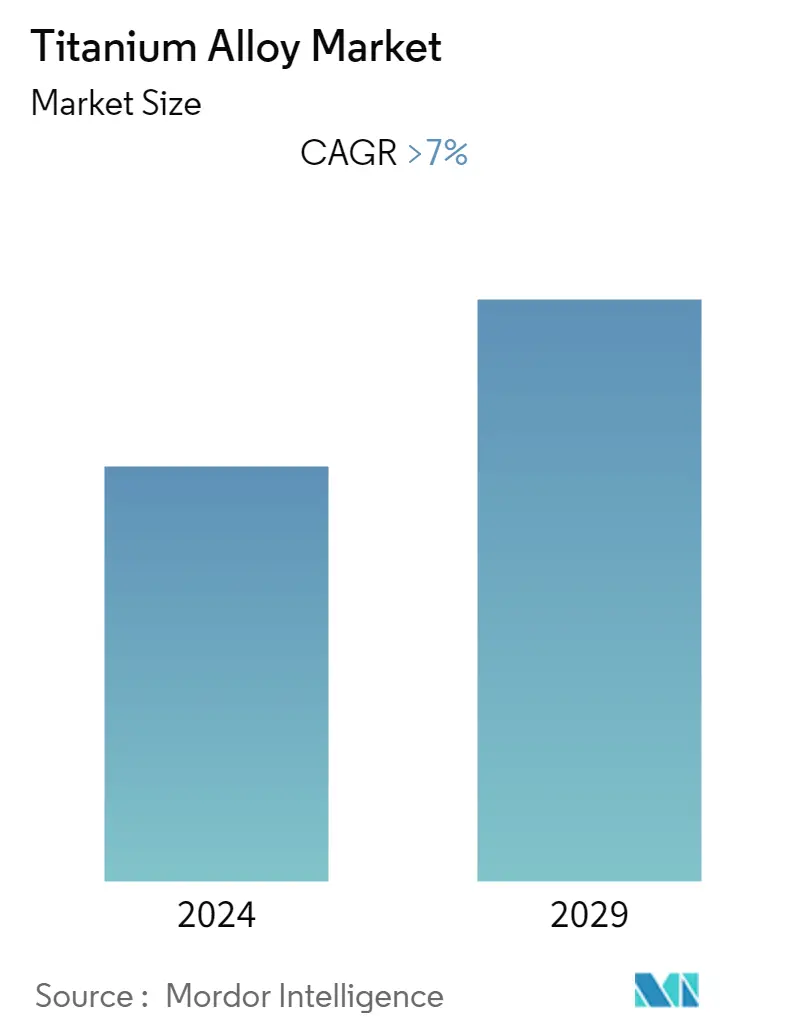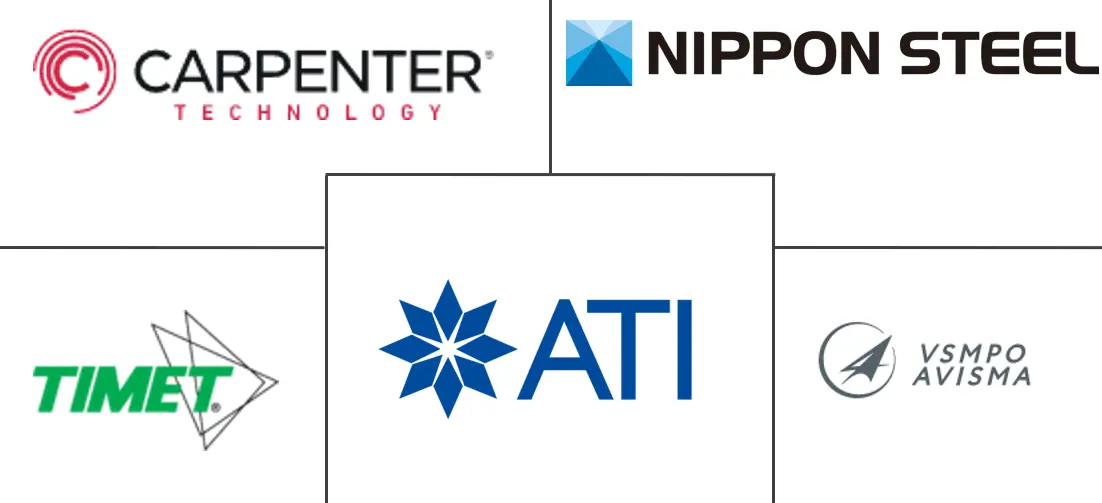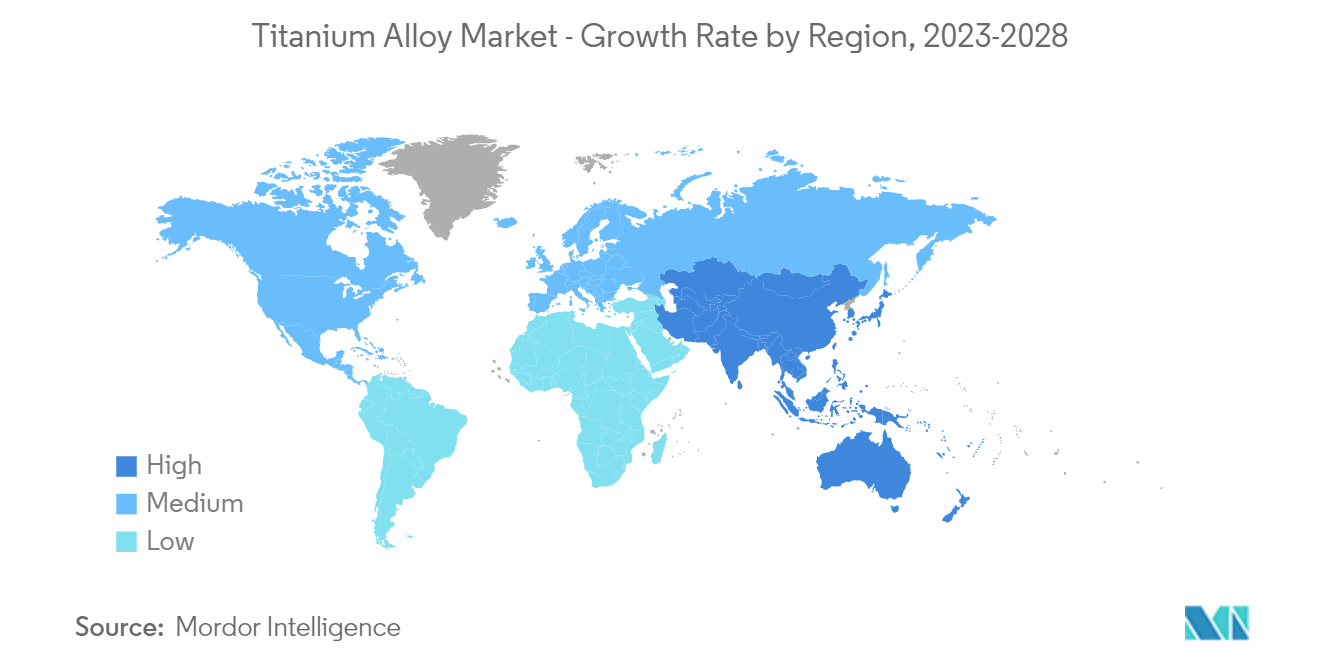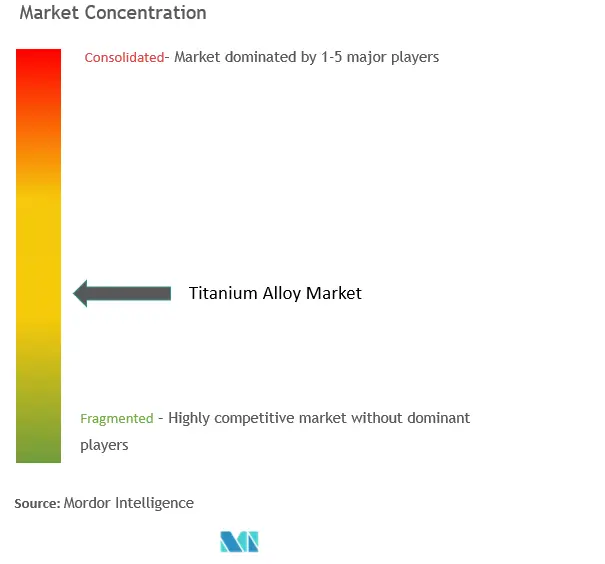Titanium Alloy Market Size

| Study Period | 2019 - 2029 |
| Base Year For Estimation | 2023 |
| CAGR | 7.00 % |
| Fastest Growing Market | Asia Pacific |
| Largest Market | Asia Pacific |
| Market Concentration | High |
Major Players
*Disclaimer: Major Players sorted in no particular order |
Titanium Alloy Market Analysis
The global titanium alloy market is expected to register a CAGR of over 7% during the forecast period.
The pandemic had a negative effect on the market, which recovered in 2021 and is expected to grow further in the forecast period.
- Over the short term, the market's growth is majorly driven by the growing usage of titanium alloys in the aerospace sector and increasing demand for titanium alloys for combat vehicles to replace steel and aluminum.
- On the flip side, the high reactivity of the alloy demands specialized care during production. This is expected to act as a restraint for the market.
- Furthermore, innovative product development will likely be an opportunity for the market during the forecast period.
- China dominates the market in the Asia-Pacific region, and it is expected to continue to do so during the forecast period. This dominance is attributed to the increasing demand from the chemical, high-end aerospace, automotive, medical, and environmental protection sectors.
Titanium Alloy Market Trends
This section covers the major market trends shaping the Titanium Alloy Market according to our research experts:
Increasing Demand of Titanium Alloys in the Aerospace Industry
- Titanium is one of the most important raw materials for the aerospace industry. Titanium alloys account for the largest share of the aerospace raw material market, closely followed by aluminum alloys.
- Titanium alloys form the third-most important raw materials used in the aerospace industry when considering the weight of raw materials. Around 75% of the high-grade titanium sponge is used in the aerospace industry. It is used in aircraft engines, blades, shafts, and airframe applications (landing gear, fasteners, and wing beams).
- Furthermore, the ability of titanium alloys to operate at severe temperatures ranging from sub-zero to over 600°C makes them valuable in aircraft engine casings and other uses. They are perfect for usage in airframes due to their great strength and low density. The aircraft sector uses Ti-6Al-4V alloys the most.
- The top two companies in the world, Boeing and Airbus, are engaged in producing airplanes, jets, helicopters, etc. Therefore, these companies are the major consumers of titanium alloys in the aerospace industry. In 2021, Airbus took gross orders for 909 aircraft. In comparison, Boeing earned 771 gross orders, a twofold increase from 2020.
- Furthermore, according to the International Air Transport Association (IATA), the global revenue for commercial airlines was valued at USD 373 billion in 2020 and was estimated at USD 472 billion in 2021, registering a growth rate of 26.7% Y-o-Y. Furthermore, the revenue was expected to reach USD 658 billion by 2022. Such factors are likely to increase the demand for titanium alloy from aerospace parts manufacturing, in the years to come.
- Aircraft manufacturers are now looking for ways to accelerate production to fill order backlogs. For instance, according to the Boeing Commercial Outlook 2022-2041, the total global deliveries of new airplanes are estimated to be 41,170 by 2041. The global airplane fleet amounted to around 25,900 units as of the year 2019 and the fleet number is likely to reach 47,080 units by 2041.

China to Dominate the Asia-Pacific Region
- China dominates the titanium alloy market in the Asia-Pacific region, which is expected to continue during the forecast period, owing to the increasing demand from the chemical, high-end aerospace, medical, and environmental protection sectors.
- The launch of new production facilities by Xinjiang New Material Co. Ltd and Chaoyang Baisheng Co. Ltd in China is expected to have a major role in boosting the production rate of titanium.
- The demand for titanium alloy in the aerospace industry in China is mainly driven by the growing manufacturing activities of the aerospace industry in the country. Aerospace is a priority industry for the country, with the government investing huge amounts to increase its domestic manufacturing capabilities.
- The Chinese aerospace policy represents one of the most comprehensive attempts to enter the top levels of aerospace development and production. China is expected to be the world's largest singlecountry market for civil aircraft sales over the next 20 years. For instance, in China, according to the Boeing Commercial Outlook 2022-2041, around 8,485 new deliveries will be made by 2041 with a market service value of USD 545 billion.
- Furthermore, titanium is used in the automotive industry for applications in connecting rods, engine valves, turbo charger wheels, exhaust systems, and suspension springs, among others. China continues to be the world's largest automotive market by both annual sales and manufacturing output. According to OICA (The Organisation Internationale des Constructeurs d'Automobiles), the vehicle production of China reached a total of 26.09 million units in 2021 which is an increase of 3% over 2020 for the same period.

Titanium Alloy Industry Overview
The titanium alloy market is partially fragmented. The major companies (not in particular order) include VSMPO-AVISMA Corporation, NIPPON STEEL CORPORATION, Allegheny Technologies Inc. (ATI), TIMET (Precision Castparts Corp.), and CRS Holdings, LLC.
Titanium Alloy Market Leaders
-
VSMPO-AVISMA Corporation
-
NIPPON STEEL CORPORATION
-
ATI
-
TIMET (Precision Castparts Corp.)
-
CRS Holdings, LLC.
*Disclaimer: Major Players sorted in no particular order

Titanium Alloy Market News
- In November 2022, PTC Industries and Defence PSU Mishra Dhatu Nigam (MIDHANI) signed a memorandum of understanding (MOU) for a technological partnership. In accordance with their MOU, PTC Industries and Midhani will make use of each other's technological resources to manufacture titanium alloy pipes and tubes using locally processed raw materials; manufacture titanium alloy plates and sheets; and fabricate critical parts and LRUs for the defense and aerospace industries using PTC's advanced machining facility and Midhani's forged and rolled products.
- In July 2022, Perryman Company, Houston, Pa., planned to significantly expand its titanium melting capacity by installing more electron beam and vacuum arc remelt furnaces. They were to be situated in Washington County, Pennsylvania. The new furnaces would increase Perryman's overall titanium melting capacity to 42 million pounds and add an additional 16 million pounds of melting capacity, solidifying Perryman's position as a global leader in titanium melting for aerospace and medical applications.
Titanium Alloy Market Report - Table of Contents
1. INTRODUCTION
- 1.1 Study Assumptions
- 1.2 Scope of the Study
2. RESEARCH METHODOLOGY
3. EXECUTIVE SUMMARY
4. MARKET DYNAMICS
-
4.1 Drivers
- 4.1.1 Growing Usage of Titanium Alloys in the Aerospace Sector
- 4.1.2 Increasing Demand for Titanium Alloys for Combat Vehicles to Replace Steel and Aluminum
-
4.2 Restraints
- 4.2.1 High Reactivity of Alloy Demands Specialized Care During Production
- 4.2.2 Other Restraints
- 4.3 Industry Value Chain Analysis
-
4.4 Porter's Five Forces Analysis
- 4.4.1 Bargaining Power of Suppliers
- 4.4.2 Bargaining Power of Consumers
- 4.4.3 Threat of New Entrants
- 4.4.4 Threat of Substitute Products and Services
- 4.4.5 Degree of Competition
5. MARKET SEGMENTATION (Market Size in Volume)
-
5.1 By Microstructure
- 5.1.1 Alpha and Near-alpha Alloy
- 5.1.2 Alpha-beta Alloy
- 5.1.3 Beta Alloy
-
5.2 By End-user Industry
- 5.2.1 Aerospace
- 5.2.2 Automotive and Shipbuilding
- 5.2.3 Chemical
- 5.2.4 Power and Desalination
- 5.2.5 Other End-user Industries
-
5.3 By Geography
- 5.3.1 Asia-Pacific
- 5.3.1.1 China
- 5.3.1.2 India
- 5.3.1.3 Japan
- 5.3.1.4 South Korea
- 5.3.1.5 Rest of Asia-Pacific
- 5.3.2 North America
- 5.3.2.1 United States
- 5.3.2.2 Canada
- 5.3.2.3 Mexico
- 5.3.3 Europe
- 5.3.3.1 Germany
- 5.3.3.2 United Kingdom
- 5.3.3.3 Italy
- 5.3.3.4 France
- 5.3.3.5 Rest of Europe
- 5.3.4 Rest of the World
- 5.3.4.1 South America
- 5.3.4.2 Middle-East and Africa
6. COMPETITIVE LANDSCAPE
- 6.1 Mergers and Acquisitions, Joint Ventures, Collaborations, and Agreements
- 6.2 Market Share(%)**/Ranking Analysis
- 6.3 Strategies Adopted by Leading Players
-
6.4 Company Profiles
- 6.4.1 AMG Advanced Metallurgical Group N.V.
- 6.4.2 ATI
- 6.4.3 BRISMET
- 6.4.4 CRS Holdings, LLC.
- 6.4.5 Daido Steel Co., Ltd.
- 6.4.6 Eramet
- 6.4.7 Hermith GmbH
- 6.4.8 Howmet Aerospace
- 6.4.9 KOBE STEEL, LTD.
- 6.4.10 M/s Bansal Brothers
- 6.4.11 Mishra Dhatu Nigam Limited
- 6.4.12 Perryman Company
- 6.4.13 TIMET (Precision Castparts Corp.)
- 6.4.14 Toho Titanium Co., Ltd.
- 6.4.15 VSMPO-AVISMA Corporation
- 6.4.16 Weber Metals (OTTO FUCHS COMPANY)
- *List Not Exhaustive
7. MARKET OPPORTUNITIES AND FUTURE TRENDS
- 7.1 Innovative Product Development
Titanium Alloy Industry Segmentation
Titanium alloys exhibit a unique combination of mechanical and physical properties, which make them desirable for certain critical applications in the aerospace, chemical, medical, and energy industries.
The Titanium Alloy Market is segmented by Microstructure (Alpha and Near-alpha Alloy, Alpha-beta Alloy, and Beta Alloy), End-user Industry (Aerospace, Automotive and Shipbuilding, Chemical, Power and Desalination, and Other End-user Industries), and Geography (Asia-Pacific, North America, Europe, South America, and Middle-East and Africa).
The report also offers market size and forecasts for 13 countries across major regions. For all the segments, the market sizing and forecasts have been done on the basis of volume (kilotons).
| By Microstructure | Alpha and Near-alpha Alloy | |
| Alpha-beta Alloy | ||
| Beta Alloy | ||
| By End-user Industry | Aerospace | |
| Automotive and Shipbuilding | ||
| Chemical | ||
| Power and Desalination | ||
| Other End-user Industries | ||
| By Geography | Asia-Pacific | China |
| India | ||
| Japan | ||
| South Korea | ||
| Rest of Asia-Pacific | ||
| By Geography | North America | United States |
| Canada | ||
| Mexico | ||
| By Geography | Europe | Germany |
| United Kingdom | ||
| Italy | ||
| France | ||
| Rest of Europe | ||
| By Geography | Rest of the World | South America |
| Middle-East and Africa |
Titanium Alloy Market Research FAQs
What is the current Titanium Alloy Market size?
The Titanium Alloy Market is projected to register a CAGR of greater than 7% during the forecast period (2024-2029)
Who are the key players in Titanium Alloy Market?
VSMPO-AVISMA Corporation, NIPPON STEEL CORPORATION, ATI, TIMET (Precision Castparts Corp.) and CRS Holdings, LLC. are the major companies operating in the Titanium Alloy Market.
Which is the fastest growing region in Titanium Alloy Market?
Asia Pacific is estimated to grow at the highest CAGR over the forecast period (2024-2029).
Which region has the biggest share in Titanium Alloy Market?
In 2024, the Asia Pacific accounts for the largest market share in Titanium Alloy Market.
What years does this Titanium Alloy Market cover?
The report covers the Titanium Alloy Market historical market size for years: 2019, 2020, 2021, 2022 and 2023. The report also forecasts the Titanium Alloy Market size for years: 2024, 2025, 2026, 2027, 2028 and 2029.
What are the current trends in the Titanium Alloys Market?
The current trends in the Titanium Alloys Market are a) Development of innovative and cost-effective production methods b) Integration of 3D printing technology for creating complex titanium alloy parts c) Focus on R&D to create new and improved titanium alloys
Titanium Industry Report
The global titanium alloys market is experiencing significant growth, driven primarily by the aerospace and defense sectors, which utilize these materials for their high strength-to-weight ratio, corrosion resistance, and ability to withstand extreme temperatures. The market is segmented by grade type, with alpha-beta alloys dominating due to their balanced properties of strength and toughness. Additionally, the automotive industry is increasingly adopting titanium alloys to enhance vehicle performance, fuel efficiency, and safety, particularly in the production of lightweight and electric vehicles. The marine industry also contributes to market demand, using titanium alloys in oceanic devices, desalination systems, and offshore drilling equipment. Technological advancements and innovations in forging processes are further propelling market growth, offering enhanced performance and cost efficiency.
The titanium market size is characterized by intense competition, with key players focusing on product innovation and strategic collaborations to expand their market presence. Statistics for the titanium market share, size, and revenue growth rate, created by Mordor Intelligence™ Industry Reports, provide a comprehensive analysis of market trends. The titanium market analysis includes a market forecast outlook and a historical overview. Get a sample of this industry analysis as a free report PDF download.
The industry analysis highlights the market segmentation and the market value, offering insights into market data and market trends. The industry outlook and market overview provide a detailed market review and market predictions, ensuring a thorough understanding of the market dynamics. The report example and report PDF serve as valuable resources for research companies and industry research. The industry information and industry reports also emphasize the market forecast and market growth, while the market leaders and market outlook offer a comprehensive industry overview.
In conclusion, the industry sales and industry size, supported by industry statistics and market segmentation, underscore the market's potential and future opportunities. The market predictions and market value, along with industry research and industry trends, provide a robust foundation for strategic decision-making. The report example and report PDF further enhance the understanding of market data and market forecast, making it an indispensable tool for industry professionals and market leaders.



